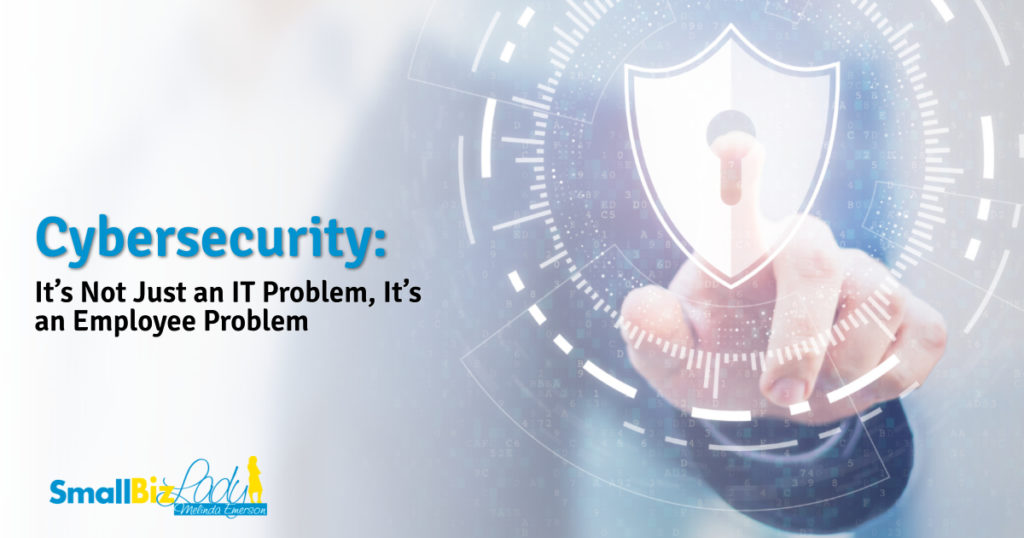Cybersecurity: It’s Not Just an IT Problem, It’s an Employee Problem

 We’re human and we all make mistakes. They say a chain is only as strong as its weakest link and when it comes to cybersecurity, the weakest link is often the people in the organization.
We’re human and we all make mistakes. They say a chain is only as strong as its weakest link and when it comes to cybersecurity, the weakest link is often the people in the organization.
Did you know that 95% of data breaches are caused by employee mistakes?
In today’s fast-paced work environments, employees let down their guard for the sake of keeping up with workloads. Rushing to get more done, people make the mistake of opening the wrong email or clicking on a malicious link.
Globally, the most common forms of attack on organizations are those that rely on deception:
- phishing (57%)
- stolen or compromised devices (33%)
- credential theft (30%).
Worse, cybercriminals are targeting small businesses more, with reports that attacks have increased since the COVID-19 pandemic.
And did you know that with 91% of cybersecurity data breaches, the entry point is from email?
So how do you avoid this?

Fostering a strong security culture within your organization is key. This means you need to empower employees to do their part in keeping company data secure and provide them the right tools to simplify the process.
Employees want to do their part to protect company data, and many haven’t recognized the importance of their role in the defense against security breaches. This leads to many employees sidestepping company security practices so that they can be more efficient.
Often, the pressure to complete a task at work often overrides the pressure to adopt security best practices, especially when the boss is asking to get something done by yesterday. Adopting new habits can interrupt workflows, even if it is far more effective in the long run.

So what can companies do to get employees thinking about security? Here are three ways you can make employees part of your company’s security solution:
- Create the “human firewall” by helping employees understand how their behavior impacts the company’s data privacy and security. When it comes to cybersecurity, anyone’s actions can make or break the effectiveness of even the best of best practices. It’s up to everyone at the company to keep corporate data safe.
- Educate them about best practices that help protect them and the business. The more familiar employees are with the dos and don’ts of cybersecurity, the more likely they are to follow them.
- Implement protection. Prevention is much less costly than being reactive to a breach. It is imperative that businesses wanting to avoid being the next headline of a breach immediately implement robust cybersecurity protection, and continuously monitor the security within their organizations.
10 Ways to Detect Phishing Emails – Best Practice Tips

To help your employees stay even safer, share these 10 phishing email tips to protect your people and data. If you follow some basic email security best practice tips, you can avoid a cybersecurity catastrophe.
- Avoid opening non-branded business email addresses from a stranger, such as gmail.com
- Take note of poorly drafted emails with grammar mistakes, formatting errors, or generic greetings
- Don’t fall for intimidating calls to action, such as money transfers ASAP, so nobody has the time to realize that something is off.
- Don’t open suspicious email attachments with file extensions that run code or macros: for example .exe attachments
- Take note of inconsistent links with different displayed and destination URLs by hovering your mouse over the link.
- Implement security awareness training, to ensure cybersecurity is always top of mind
- Setup security policies for employees to follow
- Make it easy for everyone to report suspicious email activity
- When in doubt, call the person that sent the email or delete it
- Deploy anti-phishing email technology to protect your data
 About the Author: Miguel Ribeiro is an Award-Winning business owner and entrepreneur, founder of VBS IT Services. In 2007, the company was founded with a mission to bring enterprise-level I.T. support services and solutions to small businesses.
About the Author: Miguel Ribeiro is an Award-Winning business owner and entrepreneur, founder of VBS IT Services. In 2007, the company was founded with a mission to bring enterprise-level I.T. support services and solutions to small businesses.
Read More
Source

No comments